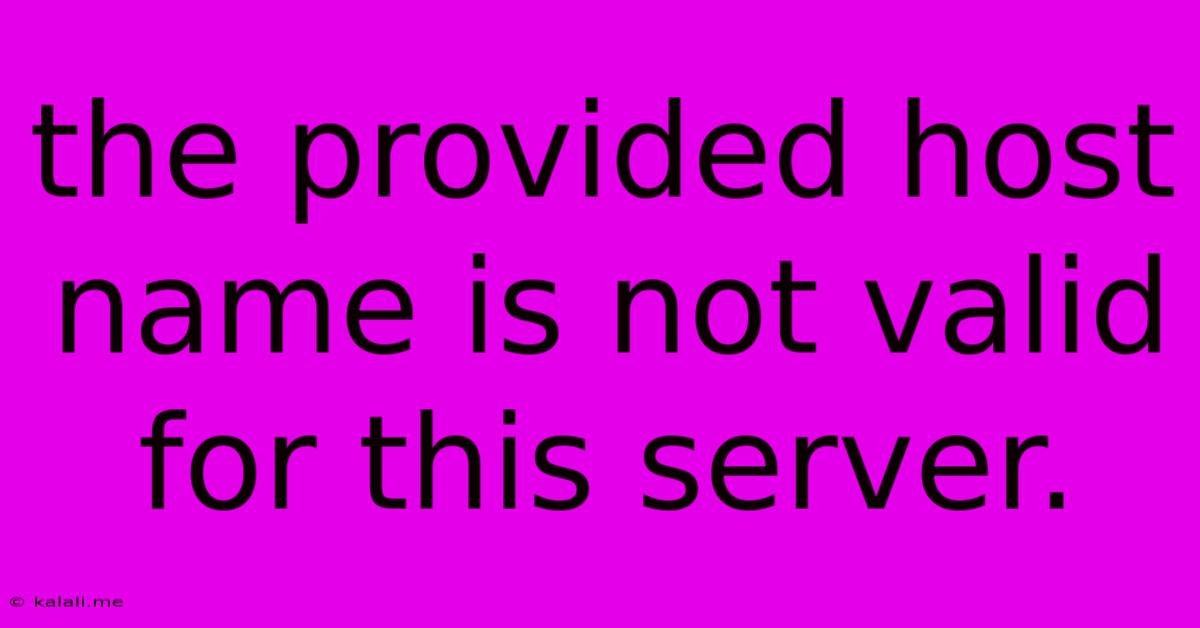The Provided Host Name Is Not Valid For This Server.
Kalali
Jun 10, 2025 · 4 min read

Table of Contents
The Provided Hostname Is Not Valid for This Server: Troubleshooting and Solutions
The dreaded "the provided hostname is not valid for this server" error message can be incredibly frustrating. This comprehensive guide will break down the causes of this error and offer practical solutions to get you back online. Whether you're a seasoned developer or a casual internet user, understanding this error is crucial for smooth online experiences. This error typically arises when your browser or application tries to connect to a server using an incorrect hostname.
This article covers the most common causes and solutions for this problem, helping you diagnose and fix the issue quickly. We will explore DNS resolution, server configurations, typos, and security implications. Let's dive in!
Understanding the Error
The "provided hostname is not valid for this server" error fundamentally means there's a mismatch between the hostname you're trying to access and the server's actual configuration. This could stem from various issues, ranging from simple typos to more complex network problems. The server is essentially saying, "I don't recognize that name; I'm not supposed to respond to that."
Common Causes and Solutions
Here are the most frequent causes of this error and their respective troubleshooting steps:
1. Typos in the Hostname:
- Problem: The most common reason is a simple misspelling of the website address (URL). A single incorrect letter or a missing character can prevent successful connection.
- Solution: Carefully double-check the hostname for typos. Pay close attention to capitalization, as some hostnames are case-sensitive. Compare it to the URL printed on any official documentation or bookmark.
2. Incorrect DNS Resolution:
- Problem: Your computer might have incorrect DNS settings, preventing it from correctly translating the hostname into the server's IP address. This could be due to outdated DNS records, incorrect DNS server configuration, or DNS caching issues.
- Solution:
- Flush DNS Cache: Clear your browser's cache and cookies. For a more comprehensive solution, flush your DNS cache using command-line tools (like
ipconfig /flushdnson Windows orsudo systemd-resolve --flush-cacheson Linux). - Check DNS Settings: Verify your computer's DNS server settings. Consider using a public DNS server like Google Public DNS (8.8.8.8 and 8.8.4.4) or Cloudflare DNS (1.1.1.1 and 1.0.0.1) for improved reliability.
- Restart your Network: A simple reboot of your router and computer can often resolve temporary DNS glitches.
- Flush DNS Cache: Clear your browser's cache and cookies. For a more comprehensive solution, flush your DNS cache using command-line tools (like
3. Server-Side Issues:
- Problem: The problem might originate from the server itself. The server might be misconfigured, experiencing downtime, or having incorrect hostname settings.
- Solution: This is beyond your control. Contact the website's administrator or support team to report the issue. Check for any announcements or status pages related to the website indicating outages or maintenance.
4. SSL Certificate Issues:
- Problem: If you're accessing an HTTPS website, an invalid or improperly configured SSL certificate can cause this error. The certificate may not match the hostname or might have expired.
- Solution: Check the website's SSL certificate details. Look for warnings or error messages related to the certificate. If the certificate is invalid, the problem lies with the server's configuration, not your end. Contact the website's administrators.
5. Firewall or Proxy Interference:
- Problem: Firewalls or proxy servers could be blocking access to the server. These security measures might filter out traffic based on hostname or other network parameters.
- Solution: Temporarily disable your firewall or proxy to check if this is the cause. If the problem disappears, you'll need to configure your firewall or proxy to allow access to the specific hostname.
6. Host File Conflicts:
- Problem: Your local
hostsfile (located inC:\Windows\System32\drivers\etcon Windows or/etc/hostson Linux/macOS) might contain outdated or conflicting entries that redirect the hostname to an incorrect IP address. - Solution: Open your
hostsfile with an appropriate text editor (e.g., Notepad) and check for any entries related to the hostname in question. Remove or correct any incorrect entries. Ensure you have administrative privileges to modify this file.
Advanced Troubleshooting
If the basic troubleshooting steps don't work, consider these more advanced techniques:
- Check your network connectivity: Ensure you have a stable internet connection. Run a ping test to the server's IP address to verify connectivity.
- Use a different browser or device: Attempt to access the website using a different web browser or a different device (e.g., smartphone). This can help rule out browser-specific issues.
- Contact your ISP: In some cases, the problem might be related to your internet service provider's network configuration.
By systematically working through these steps, you should be able to identify and resolve the "provided hostname is not valid for this server" error. Remember to prioritize security and only disable firewalls or proxies temporarily for troubleshooting purposes. If the problem persists after thorough troubleshooting, contacting the website administrator or your internet service provider is crucial for further assistance.
Latest Posts
Latest Posts
-
Composite Numbers From 1 To 1000
Jun 12, 2025
-
Which Planets Do Not Have Moons
Jun 12, 2025
-
Is A Venus Flytrap More Efective Than Pitcher Plant
Jun 12, 2025
-
Latent Learning Is An Example Of
Jun 12, 2025
-
Which Of The Following Is Not A True Statement
Jun 12, 2025
Related Post
Thank you for visiting our website which covers about The Provided Host Name Is Not Valid For This Server. . We hope the information provided has been useful to you. Feel free to contact us if you have any questions or need further assistance. See you next time and don't miss to bookmark.